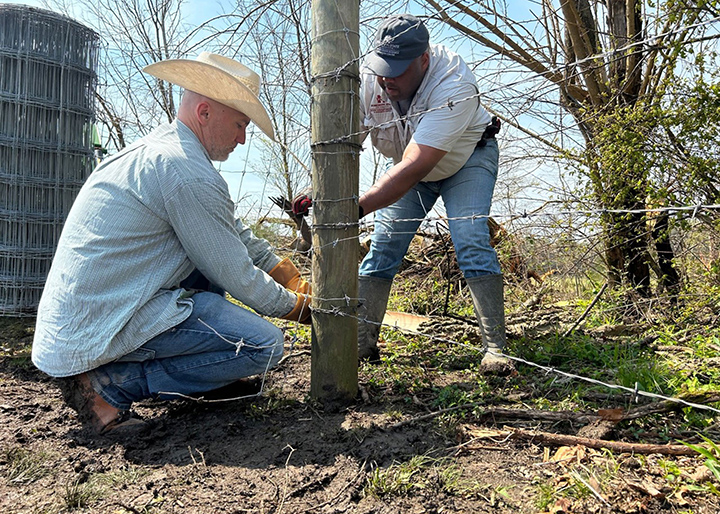MSU Extension Service work relief teams assist with storm aftermath

Mississippi State University Extension agents Ty Jones, left, and BJ McClenton tie new fencing around a post. They were part of a work relief team that helped repair damage and clear debris from a pasture in Egypt, Mississippi that was in the path of a violent March 25 tornado. PHOTO: Nathan Gregory | MSU Extension Service
On hot days, Robert Thompson’s beef cows used to retreat to a cluster of trees in the middle of his pasture for shade.
The 24-head herd will have to cool down elsewhere now as two towering brush and limb piles have replaced the resting area. Clearing a new place for the cows is one of many tasks facing Thompson after an EF-3 tornado chewed through the 18-acre grazing area in Monroe County during a March 25 severe weather outbreak.
Many of the trees there were snapped in half, and much of the livestock fencing mangled by fallen limbs and trunks. Thompson wrangled loose cows into a makeshift containment pen but needed a new permanent barrier in place.
Then there was the damage that his home had taken on. Large roof holes and busted beams are but a few signs of what he and his family endured while they were taking shelter.
A clear day and some extra labor allowed him to rebuild the new fencing so his cows could return to a full pasture less than a week after the storm passed. The assistance that day came from a work relief team from the Mississippi State University Extension Service
“We’re OK, and that’s the main thing,” Thompson said. “I’m just glad we’re able to stand here and talk about it.”
More than two dozen fatally injured storm victims did not have the same fortune. Many other storm survivors had to find temporary housing and provisions for themselves after the squall line producing this tornado decimated much of the Delta town of Rolling Fork. The same line would produce a twister that hit the northern half of Amory head-on.
Shortly after this and other natural disasters, numerous volunteer organizations rush to affected areas to help victims rebuild. The Mississippi Emergency Management Agency coordinates local response team missions, and MSU Extension is one of the agencies written into MEMA’s comprehensive emergency management plan to respond to disasters.
Emergency support functions with MSU Extension as a supporting agency include mass care services, donations management, agricultural damage assessments and work relief. Extension agents, specialists and staff assist with various recovery efforts.
Depending on the mission assignments they receive from MEMA or County Emergency Managers, those efforts can include performing agriculture damage assessments, supporting Mississippi Board of Animal Health, MEMA, and USDA Farm Service Agency, helping farmers clear debris and rebuild fencing, and staffing donation points of distribution at the local level.
B.J. McClenton, MSU Extension coordinator based in Clay County, was working with emergency personnel in Amory to staff a community distribution site there before he was assigned to conduct damage assessments and later to assist the work relief team helping Thompson.
“Local EMAs have a designated distribution and donation area figured out ahead of time, that way we can help secure a food supply and make sure people have non-perishable items and toiletries,” he said. “Usually when we get called in, we’re helping collect, sort and provide donated items to the public.”
The MSU Extension team assisting Thompson falls under the category of work relief, but in many cases work relief and damage assessment are connected.
“Agricultural damage assessments show us where we need to send work relief teams,” said Anne Howard Hilbun-Benoit, instructor with the MSU Extension Center for Government and Community Development. “We had requests from people from the Wren community in Monroe County, and we were the right people to help them as other supporting agencies helped survivors in Amory.”
Ty Jones, an MSU Extension agent based in Madison County, led the work relief team that cleared Thompson’s pasture of storm debris before helping him install the new fencing.
“When cattle get out of their pasture, it usually becomes a road hazard,” he said. “We want to help the rancher, but it’s also a community issue if they have cattle that keep coming out, and it’s obviously an animal welfare and public safety issue.”
For MSU Extension agents whose counties are affected by disasters, the work of recovery in their communities unofficially begins as soon as the danger has passed, well before receiving assignments from MEMA. Extension county coordinators Emily Carter in Sharkey County and Randall Nevins in Monroe County were among responders clearing debris from roads and helping people find shelter and basic necessities.
“We got to work first thing early next morning. I was clearing roads with anybody I could find so folks who had been trapped at home could get through,” Nevins said. “We’re trying to be of service to these folks. There’s a lot of destruction across the county from one side to the other. It’s devastation, debris and just a lot of damage all the way across.”
Mississippi State University is taking care of what matters. Learn more at www.msstate.edu.
Nathan Gregory | MSU Extension Service



